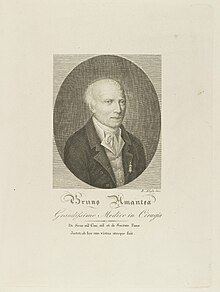
Bruno Amantea (circa 1750 – 10 April 1819) was an Italian physician and surgeon active in Naples.
Biography
He was born in Grimaldi near Cosenza. His father was also a surgeon. After initial studies in his native town, he studied under the Jesuits in Cosenza, then moved to Naples at the age of 18, to study at the college attached to the Ospedale degli Incurabili, where he trained under Domenico Cotugno, Sabato Mauro, and Nicola Franchini. after five years, he had an appointment as surgeon at this hospital. There he joined the teams of Pollio, Mirra and Perrano. He published a treatise on L'estrazione della pietra della vescica orinaria (On "The removal of stones from the urinary bladder"). He benefited from an apparatus invented in 1722 by Mariano Santo. He also performed hernia, cataract, and popliteal aneurysms surgeries. In 1792, he was named professor of anatomy. In 1798, he was nominated chief surgeon to the Neapolitan army in Sangermano. He was enrolled in various national academies. In 1815, the restored King Ferdinand I named him surgeon of the royal suite. [1] [2]
References
- ^ Dizionario biografico universale, Volume 1, compiled by Gioacchino Maria Olivier-Poli, Naples (1824); page 47–48.
- ^ Ultimi uficii alla memoria del cavalier Bruno Amantea, by Niccolo Ciampitti, (written in Latin) Stamperia Reale, Naples, 1822.